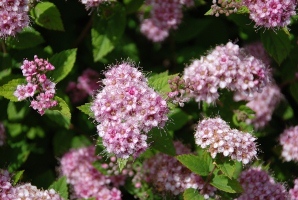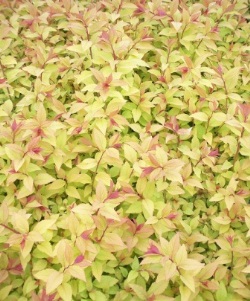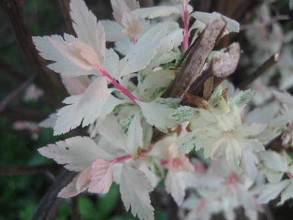Tea Bush, Australian Tea Tree, New Zealand Tea Tree, Manuka Myrtle - Leptospermum scoparium
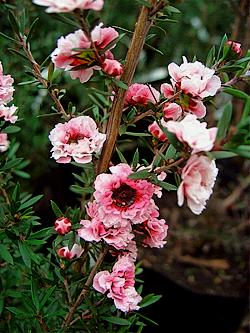 'Sunraysia'Condensed Version:
'Sunraysia'Condensed Version:
Tea bushes are old time favourites for cold South African gardens because they can be depended upon to produce a show stopping abundance of flowers in winter and spring. The delicate flowers can be single or double and come in all shades of pink, red or white. The fine, needle-like foliage is highly aromatic when crushed, and the flowers are followed by attractive, small woody capsules containing tiny seeds, hanging on for a long time after the petals have dropped.
In the garden, depending on climatic conditions, the tea bush generally grows anything from 1.5 to 3m tall with a spread of 1.5m to 2m. It adds ornamental appeal to the landscape all year round and looks beautiful in a mixed shrub border, and can be planted close together to form a screen. Because they are available as standard plants, and miniatures like 'Cherry Brandy' are perfect for growing in containers and small gardens, there is a cultivar for all tastes.
The tea bush loves full sun, where it will flower abundantly, it will however, take light shade. Excluding the humid regions, it grows well in all areas of the country, and does well in cooler coastal conditions. It is also cold hardy, tolerating frosts down to -7°C. For excellent results in the garden, plant it in a position which is sheltered from cold or hot, drying winds.
Although it prefers fertile, acidic soils which drain well, the tea bush will adapt to most garden soils with excellent drainage. Water young plants regularly, but once established the tea tree will only require moderate watering.
Because they have a shallow root system the plants hate disturbance, avoid digging around the roots. Minimal pruning is required but the plant can be clipped into shape after it has finished flowering. Plants should not be trimmed back into old wood, however, because they do not regenerate from such treatment.
 'Burgundy Queen'Full Version:
'Burgundy Queen'Full Version:
Description, History & Interesting Facts:
These natives of Australia and New Zealand are old time favourites for cold South African gardens because they can be depended upon to produce a show stopping abundance of flowers in winter and spring. The delicate flowers can be single or double and come in all shades of pink, red or white, and are magnets for bees. The flowers are followed by attractive, small woody capsules containing tiny seeds, hanging on for a long time after the petals have dropped.
Leptospermum scoparium is a member of the family Myrtaceae, along with the Mediterranean shrub Common Myrtle (Myrtus communis,) and well-known Australian plants such as the gum trees (Eucalyptus) and bottlebrushes (Callistemon.) The tea bush is thought to have originated in Australia and then spread to New Zealand, where it is now much commoner. In New Zealand it grows in a wide range of areas from peaty bogs to coastal and montane regions, so it is surprisingly adaptable, especially to arid sites and soils.
In its native habitat it is a shrub or small tree, typically forming scrub 2 to 5 metres tall, but capable of growing up to 15 metres. It is often one of the first species to regenerate on land that has been cleared. In the garden, depending on climatic conditions, the tea bush generally grows anything from 1.5 to 3m tall with a spread of 1.5 to 2m. Delightful dwarf varieties have been bred, which only grow about 1m in height, and varieties like 'Cherry Brandy' with its gorgeous, dark plum-coloured leaves and cherry-red flowers have become immensely popular with gardeners, so no matter how large or small your garden is, you sure can have a tea bush.
The tea bush adds ornamental appeal to the landscape all year round, and the fine, needle-like foliage is highly aromatic when crushed. The name "tea bush," which persists to this day, comes from reports that Captain Cook brewed tea from the small needle-like leaves of this plant. However, this plant should not be confused with real tea which comes from Camellia sinensis.
Uses:
The fresh, pungent leaves are a fragrant and refreshing tea substitute of excellent quality. In taste trials this species has often received higher marks than the traditional China tea obtained from Camellia sinensis. It is important to brew the leaves for considerably longer than normal teas to ensure the flavour is released into the water.
The wood of the tea bush is red and strong and is used for inlay work, cabinet making etc. It also makes good shock resistant handles for tools and excellent firewood, even the bark is used for roofing huts.
In the Garden:
These hardy plants look beautiful a mixed shrub border and can be planted close together to form a screen. They are available as standard plants; and miniatures like 'Cherry Brandy' are perfect for growing in containers and small gardens.
![]() Cultivation/Propagation:
Cultivation/Propagation:
The tea bush loves full sun, where it will flower abundantly, it will however, take light shade. This ornamental evergreen is cold hardy, tolerating frosts down to -7°C. Excluding the humid regions, the tea bush grows well in all areas of the country, and does well in cooler coastal conditions. For excellent results in the garden, plant it in a position which is sheltered from hot or cold drying winds.
Although it prefers fertile, acidic soils which drain well, the tea bush will adapt to most garden soils with excellent drainage. If you know your soil is alkaline, add copious amounts of acid compost to the planting holes, and mulching seasonally with acid compost will maintain acidity, and conserve moisture around the roots during our hot and sometimes dry summers. Water young plants regularly, but once established the tea trees will only require moderate watering to keep them looking at their best.
Because they have a shallow root system the plants hate disturbance, so avoid digging around the roots - remove weeds, etc. gently by hand. Minimal pruning is required but the plant can be clipped into shape after it has finished flowering. Plants should not be trimmed back into old wood, however, because they do not regenerate from such treatment.
Propagation is usually by cuttings and seed is also viable.
![]() Problems, Pests & Diseases:
Problems, Pests & Diseases:
If it is grown correctly and in the right climate, the tea tree is virtually disease and pest free.
A prevalent pest is scale, which is usually associated with black smut, causing an unsightly blackening of the foliage. Treatment is to spray with white oil when the crawling stage of the insect is mobile, usually in early spring. Later applications should have an insecticide added to the white oil solution, to obtain effective control.
Borers may also attack tea trees and their presence is made apparent by small piles of sawdust-like frass on the branch forks or near the base of the shrub. The safest method of control is to use a small syringe containing methylated spirits and squirt it into the hole made by the borer.
Root rot may occur in overly moist soils.
Warning:
We could not find Leptospermum scoparium listed in any poisonous databases for human’s cats or dogs.
Forest Bell Bush, Bosklokkiesbos, Mufhanza - Mackaya bella
 Mackaya bella
Mackaya bella![]() Condensed Version:
Condensed Version:
This gorgeous indigenous evergreen is wonderful in shady gardens; producing arching sprays of white or lavender, bell-shaped flowers, marked with delicate purple or pink lines in the throat or on the petals. It flowers profusely in spring and summer, but has a long flowering period and may even flower until early December, depending on climate. The large, glossy, dark-green leaves are also most attractive. If grown under ideal conditions, this beautiful plant is long-lived with an upright growth habit, +-1.5 to 3m tall, with an almost equal spread of about +-2m, if left un-pruned. The forest bell will thrive if planted amongst trees or near water, growing even in dense shade. It can be trained to grow as a large shrub or small tree, and is an excellent choice for an informal hedge or screen. It also grows beautifully in large containers. Because the roots are non-invasive, it is perfect for even tiny gardens.
The forest bell bush grows best in the humid, sub-tropical and frost-free summer rainfall regions of South Africa, but also does well in the winter rainfall regions if it is watered well in summer and is planted in well-drained soil. Although it is tender to frost it can be grown in colder inland gardens which experience short spells of low temperatures down to 0°C; and will even tolerate lower temperatures if it is planted in a wind protected and very sheltered part of the garden. If it does get frosted, the damaged branches can be pruned hard in early summer to encourage new growth from the base; but unfortunately, the early spring flowers will be affected.
Although it will grow in dense shade, it may not flower that well, preferring a bright shady position in the garden which is sheltered from strong winds. In coastal gardens it will take more sun, but in too much sun the leaves will have a yellow look. This plant thrives in deep, heavily composted, well-drained soil. Water regularly in the first year to get it established, and moderately thereafter during dry summer spells. During the summer months an application of 3:1:5 every 6 weeks is beneficial. This plant responds well to pruning and can be kept nice and compact if it is pruned ever year after it has finished blooming. Light pruning during summer is also fine.
Full Version:
Description, History & Interesting Facts:
This gorgeous indigenous evergreen is wonderful in all shady gardens, and occurs only in certain regions of South Africa, and nowhere else in the world; and is therefore referred to as "endemic" to this region. It is a member of the large Acanthaceae family which includes other South African favourites for the garden like the beautiful Black-eyed-Susan creeper (Thunbergia alata) and the Bush Violet (Barleria obtusa). It is the only member of the genus Mackaya and can be found growing wild in evergreen forests, where it loves to grow alongside streams; occurring from the coastal areas of the Eastern Cape to KwaZulu-Natal and Swaziland, as well as in Mpumulanga and Limpopo. Bella means "beautiful" in Latin, and is a tribute to the arching sprays of white or lavender, bell-shaped flowers. The flowers are marked with delicate purple or pink lines in the throat or on the petals. The forest bell bush flowers profusely in spring and summer, but has a long flowering period and may even flower until early December, depending on climate. The large, glossy, dark-green leaves are borne on long slender stems, and are also most attractive. If grown under ideal conditions, this beautiful plant is long-lived with an upright growth habit, +-1.5 to 3m tall, with an almost equal spread of about +-2m, if left un-pruned.
In the Garden:
The forest bell bush is essential for all shady gardens and will thrive if planted amongst trees or near water, growing even in dense shade. This versatile plant can be trained to grow as a large shrub or small tree, and is an excellent choice for an informal hedge or screen. It also grows beautifully in large containers. Because the roots are non-invasive, it is perfect for even tiny gardens and can safely be planted near to swimming pools and foundations. The flowers will attract carpenter bees and are a favourite food source for the blue-pansy butterfly (Junonia oenone oenone)
Cultivation:
The forest bell bush grows best in the humid, sub-tropical and frost-free, summer rainfall regions of South Africa, but also does well in the winter rainfall regions if it is watered well in summer and is planted in well-drained soil. Although it is tender to frost, it can be grown in colder inland gardens which experience short spells of low temperatures down to 0°C; and will even tolerate lower temperatures if it is planted in a wind protected and very sheltered part of the garden; under the eaves of the house; or in pots which can be moved or covered during the coldest months. If it does get frosted, the damaged branches can be pruned hard in early summer to encourage new growth from the base; but unfortunately, the early spring flowers will be affected.
Although it will grow in dense shade, it may not flower that well, preferring a bright shady position in the garden which is sheltered from strong winds. In coastal gardens it will take more sun, but in too much sun the leaves will have a yellow look. This plant thrives in deep, heavily composted, well-drained soil. Water it regularly in the first year to get it established, and moderately thereafter during dry summer spells. In winter it is quite drought hardy and in colder regions, should be kept on the dry side until August. During the summer months an application of 3:1:5 every 6 weeks is beneficial. This plant responds well to pruning and can be kept nice and compact if it is pruned ever year after it has finished blooming. Light pruning during summer is also fine.
Propagation:
It is easily propagated from semi-hardwood cuttings taken in spring or autumn. Fresh seed sown in spring also germinates well.
Pests & Diseases:
If grown correctly the forest bell bush does not suffer from many pests or diseases, but in very sheltered gardens with insufficient air circulation, it is susceptible to spider mites and whiteflies.
Common Myrtle - Myrtus communis
 Myrtus communisCondensed Version:
Myrtus communisCondensed Version:
The beautiful common myrtle has an elegant growth habit and its tolerance of continual clipping makes this shrub a favourite for topiary; and if planted closely together it makes a wonderfully thick formal hedge, if left unpruned will grow into a delightfully shaped shrub; perfect for cottage gardens and informal shrub borders, screens and hedges. They also grow happily in pots, making them perfect candidates for city and courtyard gardens.
Common Myrtle is a dense evergreen with small aromatic, glossy emerald green leaves, and in summer an abundance of fragrant white flowers appear, followed by blue-black berries which are relished by birds. The bark is reddish brown and on older plants peels off in stripes or slabs.
Growth is moderate to slow, depending on climate, to +-1.5 or 2.5m tall and +-1.5 to 2.5m wide, if the plant is un-pruned. Several smaller-growing garden varieties are available, varying in height from 1.5 to 2m; often with lovely variegated, green and pale yellow leaves.
There are several varieties to choose from;including dwarf forms.
Myrtle grows best in temperate regions with mild winters, but will tolerate moderate frost if it is planted in a warm, sheltered position in the garden. This plant tolerates poor soil and brak (salty) water, sea winds and salt spray; but is not suited to very humid regions. It grows in most well-drained garden soils; tolerating acid, alkaline and neutral soils. Although it tolerates heat and drought, it will look at its best in the garden if it is watered regularly in hot, dry regions. Plant it in full sun or very light shade.
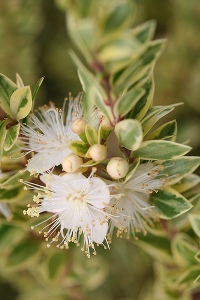 Myrtus communis 'Compacta Variegated' Picture courtesy Green Acres Nursery CaliforniaFull Version:
Myrtus communis 'Compacta Variegated' Picture courtesy Green Acres Nursery CaliforniaFull Version:
Description, History & Interesting Facts:
The beautiful common myrtle belongs to the very large Myrtaceae family of plants which consists mainly of trees and shrubs; of which the Eucalyptus or Australian gum is probably one of the best known in South Africa. Planted by the settlers as windbreaks, and used for building timber and firewood, these gums quickly established themselves, much to the detriment of our indigenous species. Today, they may only be planted in commercial forestry plantations and are being eradicated elsewhere. A wide range of tropical fruits like guavas also belong to this family; as do cloves (Syzigium aromaticum); and allspice (Pimenta dioica). Although a large portion of the myrtle family is indigenous to Australia, we also have our very own beautiful wild myrtles (Eugenia) and water berry trees, Umdoni (Syzygium.)
Common myrtle (Myrtus communis) is native across the dry, warm areas of western Asia and southern Europe (Mediterranean); especially in the islands of Sardinia and Corsica, where it is known locally by the name of ‘murta’. The name means love and devotion; and it is also known as the bride's flower because ancient legend dedicates it to Venus, the goddess of love. In the middle ages it was used prominently at weddings; in flower arrangements and to decorate cakes, doors and pews. Adding sprigs of myrtle to wedding bouquets remains a European custom; and since a sprig from Queen Victoria's wedding bouquet was grown from a slip, it has been included in British royal wedding bouquets. In Jewish liturgy, it is one of the four sacred plants of Sukkot, the Feast of Tabernacles, representing the different types of personality making up the community. In neo-pagan and Wicca rituals myrtle is commonly associated with and sacred to Beltane (May Day).
Common Myrtle is a dense evergreen shrub with small aromatic, glossy emerald green leaves, which exude a soft eucalyptus aroma reminiscent of the Australian gum to which it is closely related. Cells filled with essential oils can be distinguished as light dots when the leaves are held against the light. In summer an abundance of fragrant white flowers appear and are followed by blue-black berries which are relished by birds when they ripen in autumn and winter. The bark is reddish brown and on older plants peels off in stripes or slabs. Growth is moderate to slow, depending on climate, to +-1.5 or 2.5m tall and +-1.5 to 2.5m wide, if the plant is un-pruned. Several smaller-growing garden varieties are available, varying in height from 1.5 to 2m; often with lovely variegated, green and pale yellow leaves.
There are several varieties to choose from;
(Myrtus communis subsp. tarentina) is a dense sprawling shrub that can be beautifully shaped. It grows about 2m tall.
(Myrtus communis subsp. tarentina 'Variegata') has beautiful pale yellow leaves with green streaks. It grows about 2m tall.
(Myrtus communis 'Nana') has tiny leaves and grows about 1.5m tall.
Uses:
Common myrtle is used in the islands of Sardinia and Corsica to produce an aromatic liqueur called ‘Mirto’ by macerating the berries in alcohol. The berries, whole or ground are also used as a substitute for pepper. The leaves and flowers are dried for potpourris and the leaves can be rubbed into wooden furniture to give it a gleam and a juniper-like scent. The wood is tough with a density of 0.95 g/cm³ and when air dried is easy to work, making it good for turnery, for marquetry, furniture construction and to make sculptures.
![]() Health Benefits:
Health Benefits:
The oil of Myrtus communis has antibacterial, anti-inflammatory, analgesic (pain killing) and decongestive qualities; and some commercial products used to treat bronchial diseases contain agents obtained from Myrtle leaves. In recent years certain substances of Myrtus communis have been tested for effectiveness against cancer and it seems that the results are quite promising since there is at least one patent pending. Myrtle tea is also used as a soothing skin lotion and a compress to reduce haemorrhoids and relieve aching muscles and sprains. It also makes an excellent hair rinse and will invigorate and cleanse the scalp.
Myrtle tea is made by simmering a pot of myrtle leaves and flowers in water with the lid on for about 20 minutes before cooling, straining and bottling.
Culinary:
Both the seeds and flowers are edible and are used to flavour pork and game dishes. The buds are picked and the seeds dried and ground with pepper to make a delicious condiment. The stems make perfect braai skewers and will add flavour to lamb or pork.
In the Garden:
Its elegant growth habit and it tolerance of continual clipping makes this shrub a favourite for topiary; and if planted closely together it makes a wonderfully thick formal hedge. Myrtles are wonderful in Mediterranean style gardens; and because they were an indispensable feature of Roman gardens, and were introduced as a garden plant wherever the Roman elites settled; myrtles lend themselves perfectly to this grand style of architecture and all other formal garden styles. If left unpruned the common myrtle will grow into a delightfully shaped shrub; perfect for cottage gardens and informal shrub borders, screens and hedges. They also grow happily in pots, making them perfect candidates for city and courtyard gardens.
![]() Cultivation/Propagation:
Cultivation/Propagation:
Myrtle grows best in temperate regions with mild winters, but will tolerate moderate frost if it is planted in a warm, sheltered position in the garden, and the roots are thickly mulched in winter. In cold regions it can be grown in pots which can be moved to more favourable positions in winter. This plant tolerates poor soil and brak (salty) water, sea winds and salt spray; but in these situations will look at its best if it receives some shelter from fierce winds, is planted with lots of added organic matter, and is watered regularly. Myrtle is not suited to very humid regions. It grows in most well-drained garden soils including chalk, clay, sand, and loam soils; tolerating acid, alkaline and neutral soils; iron chlorosis (yellowing of the leaves) will develop in highly alkaline soil conditions. Although it tolerates heat and drought, it will look at its best in the garden if it is watered regularly in hot, dry regions. Plant it in full sun or very light shade.
Propagation is by seed or semi-hardwood cuttings taken in summer. Look for new growth that has started to firm up and choose non-flowering shoots if possible (otherwise remove the buds). Plant into a 50% cent mixture of sand and compost, and place the cuttings out of direct sunlight. Rooting should take approximately 6 to 12 weeks. Pot up individually in gritty compost and overwinter in a sheltered, frost-free place until the following spring before planting out into the garden.
The Myrtle family is much loved throughout the world, but in many countries, including South Africa, certain species have been declared alien invader plants because of their invasiveness.
![]() Pests & Diseases:
Pests & Diseases:
If grown correctly this plant is fairly pest and disease, but is prone to infestation by scale insects and subsequently sooty mold may develop. Root rots occur on wet soils, and thrips and spider mites can attach in hot weather.
Caution:
The information contained within this website is for educational purposes only, recording the traditional uses of specific plants as recorded through history.
The essential oil contained in the leaves of Myrtus communis plants is slightly toxic. It may cause headaches, nausea, indigestion, and may colour urine purple if consumed in larger quantities (above 10 ml). Always seek advice from a medical practitioner before starting a home treatment programme.
Plumbago, Cape Leadwort, Blousyselbos, umabophe, umasheleshele, utshilitshi - Plumbago auriculata
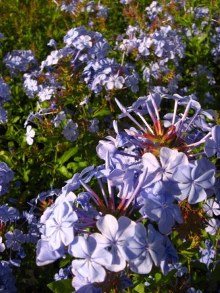 Plumbago 'Royal Cape' Condensed Version
Plumbago 'Royal Cape' Condensed Version
This evergreen grows best in the warm frost-free regions of the country and at the coast, but is also hardy to moderate frost, but in cold regions it will lose its leaves in winter. It grows in full sun or semi-shade, and is adaptable to most garden soils. If left un-pruned, it can scramble +-1.8 to 3mall; but is easily kept as a shrub, +-1m tall and wide. Watered regularly during dry spells, and feed in spring and summer with a balanced organic fertiliser.
Full Version:
Description, History & Interesting Facts:
The genus Plumbago comprises of about 15 species from the warmer parts of the world, five of which are indigenous to South Africa. It is commonly found growing wild from the southern to the eastern Cape, and into KwaZulu-Natal. It also occurs in Gauteng and the adjacent areas of the Free State, the North West Province, and an isolated distribution in Mpumalanga. It is most commonly found in valleys, growing in thickets and bushveld scrub.
This scrambling plant is grown for its abundant trusses of pale sky-blue flowers; 'Royal Cape' is a wonderful hybrid with dark cobalt-blue flowers, and 'Alba' has pure white blooms which glow in the twilight.
Flowers can appear sporadically during the growing season, but is especially prolific in mid to late summer (November to May). Both the flowers and seed capsules are sticky, and the sticky pods attach themselves to animals, helping to disperse the seeds. Traditionally a stick of Plumbago is placed in the thatch of huts to ward off lightning, and it is taken as a snuff for headaches, as well as to ward off bad dreams.
In the Garden:
Plumbago is essential in any butterfly garden and is one of the host plants for the larvae of the common blue butterfly (Cyclyrius pirithous). It is also great to plant in the exclusion area of the bird garden, providing privacy and cover for shy birds like Robins. If left un-pruned it will clamour up existing shrubs and trees, and looks lovely trained along a wire fence or wooden trellis. It also looks wonderful spilling down a bank or over a low wall. It makes a showy informal hedge, and if it is pruned regularly can be trained to form a round bushy shrub for the border. It is also available as a standard plant, and grows easily in pots, making it perfect for small gardens.
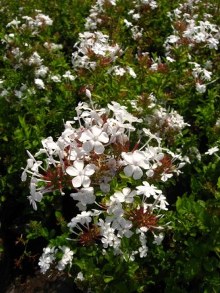 Plumbago White Cultivation/Propagation:
Plumbago White Cultivation/Propagation:
This evergreen perennial shrub grows best in the warm frost-free regions of the country and at the coast. It is semi-hardy to moderate frost, but in cold regions it will lose its leaves in winter. In very cold regions the entire plant will be cut right back to the ground in winter, but if the roots are thickly mulched to keep them from freezing, it will shoot again in summer. In these regions position the plant in a warm protected part of the garden and cover young plants until established.
Plumbago will grow well in full sun or semi-shade, but in too much shade it will not flower well. Although it is adaptable to most garden soils, it prefers a slightly acidic well-drained soil; which is a mixture of loamy and light sandy soils. If left un-pruned, it can scramble +-1.8 to 3mall; but is easily kept as a shrub, +-1m tall and wide. Although it is very drought tolerant it will respond well in the garden if it is watered regularly during dry spells. Feed in spring and summer with a balanced organic fertiliser.
Propagation is easy from semi-hardwood cuttings taken in summer or autumn, or by lifting the suckers. Seeds will also germinate readily in spring.
September Bush, Butterfly Bush, Purple Broom, Augustusbossie, ulopesi; umabalabala - Polygalas
 Polygala myrtifolia
Polygala myrtifolia![]() Condensed Version:
Condensed Version:
Polygalas bloom for a long time in the garden, and are not only charming, but also pretty tough and obliging, growing inland and at the coast. They are low maintenance, water-wise plants, which can be grown in semi-shade and full sun. Polygala species vary in growth habit but they all have upright-growing stems and gracefully slender branches, densely covered with glossy, myrtle-like leaves, which can be green or slightly grey. Flowers come in shades of mauve or purple, but can also be pink, scarlet, or white; and although they can appear sporadically throughout the year, flowering peaks in late winter, spring, and early summer. Because polygalas come in tall and dwarf forms, grow very quickly, and do not have invasive roots, they are perfect for gardens large and small – even a small balcony garden could support one.
Polygalas are fast growing evergreens, and there are species available for all climates. Some forms are very frost hardy, and all are suitable for windy, coastal gardens. They adapt to most soil types, but prefer well-drained soils that are moderately fertile, so add compost to impoverished soils. Water young plants regularly until they are well established, after which they are quite drought hardy.
Full Version:
Description, History & Interesting Facts:
Polygalas bloom for a long time in the garden, and are not only charming, but also pretty tough and obliging, growing inland and at the coast. They are low maintenance, water-wise plants, which can be grown in semi-shade and full sun. And, because they also attract wildlife to the garden, polygalas have caught the attention of eco-conscious gardeners around the country.
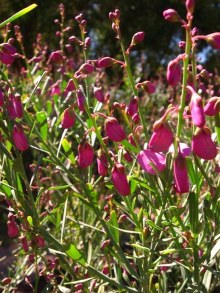 Polygala virgata. Picture courtesy www.newplant.co.zaMembers of this large family of plants occur in temperate and warm climates around the world; and include perennials, shrubs and trees. Some of the other common names for them include milkwort and false legume. Although their pea-like flowers resemble those of legumes, polygalas are easily distinguished from legumes by the feathery tuft on their lower petals. There are approximately 88 species of Polygala that occur in southern Africa, and they are especially prolific in the south-western Cape; and common from near Clanwilliam in the Western Cape, to Kwazulu-Natal. However, polygala can be found growing wild in both the summer and winter rainfall regions of South Africa, and in most provinces. These showy indigenous plants are widespread pioneer shrubs, which can commonly be found growing on dunes and rocky slopes, as well as in scrub and open grasslands; thriving in forests, and alongside streams.
Polygala virgata. Picture courtesy www.newplant.co.zaMembers of this large family of plants occur in temperate and warm climates around the world; and include perennials, shrubs and trees. Some of the other common names for them include milkwort and false legume. Although their pea-like flowers resemble those of legumes, polygalas are easily distinguished from legumes by the feathery tuft on their lower petals. There are approximately 88 species of Polygala that occur in southern Africa, and they are especially prolific in the south-western Cape; and common from near Clanwilliam in the Western Cape, to Kwazulu-Natal. However, polygala can be found growing wild in both the summer and winter rainfall regions of South Africa, and in most provinces. These showy indigenous plants are widespread pioneer shrubs, which can commonly be found growing on dunes and rocky slopes, as well as in scrub and open grasslands; thriving in forests, and alongside streams.
Polygala species vary in growth habit but they all have upright-growing stems and gracefully slender branches, densely covered with glossy, myrtle-like leaves, which can be green or slightly grey. Flowers come in shades of mauve or purple, but can also be pink, scarlet, or white; and although they can appear sporadically throughout the year, flowering peaks in late winter, spring, and early summer. Light brown fruits follow the flowers, and seedlings often germinate close to the parent plant.
Because polygalas come in tall and dwarf forms, grow very quickly, and do not have invasive roots, they are perfect for gardens large and small – even a small balcony garden could support one. And considering their toughness and attraction for wildlife, why not spoil yourself, and mother-nature with one of our very own beauties – you won’t be disappointed!
(Polygala myrtifolia) is the most well-known polygala and can be found growing wild in both the summer and winter rainfall regions; from Niewoudtville in the north-western Cape to the south-western and Eastern Cape, extending into KwaZulu-Natal, and northern Lesotho. It occurs in a wide variety of habitats, like dune scrub, grassy slopes, and along the margins of forests and streams. This polygala is saline tolerant and a perfect coastal and pioneer plant. It is drought hardy once established, withstanding long periods of drought and high temperatures. It is also able to survive low temperatures and moderate frost, but in colder regions, will require protection in winter. This polygala varies in height and spread, depending on climatic conditions, but generally forms a medium-sized shrub +-1 to 3m tall, with an attractive rounded crown and an almost equal spread. Its glossy, myrtle-like leaves are variable in shape, and the flowers come in shades of magenta and mauve, to white. Flowering can occur intermittently throughout the year, but is especially prolific in late winter to early spring and summer, peaking in October. Some forms of P. myrtifolia have thin, needle-like leaves, and can grow into a small tree, about 4m tall.
(Polygala myrtifolia 'Glentana') is similar to P. myrtifolia, and produces purple flowers, but is much shorter, with a more compact growth habit, and smaller leaves.
(Polygala myrtifolia ‘White Feathers') is similar to P. myrtifolia, but bears an abundance of white flowers from August to October, and sporadically throughout summer. Its leaves are also slightly greyer, making this polygala a perfect contrast for many other flowering shrubs, of various leaf forms and colours.
(Polygala fruticosa) has a long flowering time during the summer months, but reaches its peak between September and November, carrying its magenta flowers at the tips of its branches. The green-grey leaves are also most attractive. It occurs from the south-western Cape to KwaZulu-Natal; grows up to 2m tall; and tolerates acid or alkaline, sandy and clay soils, as long as they drain well. Because it grows naturally next to the sea it is an ideal shrub for coastal gardens, but it will also tolerate moderate frost once established. When young, protect it in winter, and try to site it in a sheltered part of the garden.
(Polygala fruticosa 'Southern Shores') was selected by Kirstenbosch horticulturalists for its round and compact growth habit, +-1m tall. This popular polygala has attractive, bluish-green leaves and rewards the gardener with masses of dark magenta flowers. Because it grows naturally next to the sea it is an ideal small shrub for coastal gardens, tolerating drought and high temperatures with ease. It is a wonderful container plant, does well in a mixed border, and grows very well in rockeries, on slopes, and in retaining walls.
(Polygala fruticosa 'Petite') is a hardy, little shrub, growing 40cm to 1m tall, with clusters of magenta flowers from August to May. It is hardy to frost if protected when young; and tolerates quite dry conditions. The shiny, grey-green, heart-shaped leaves have red margins, and the young leaves are a shiny, coppery pink. This beautiful plant is great in a mixed border, rockeries, retaining walls, or containers.
(Polygala virgata) is a slender evergreen shrub with a willowy branched crown, growing +-1.5 to 2.5m tall. It grows wild in both the winter and summer rainfall regions of the country; from the southern Cape to Limpopo, and extending into tropical East and West Africa. It grows naturally along forest margins and next to streams, on bushy hillsides, and on sandstone, clay, or limestone slopes. This outstanding garden plant produces masses of erect or drooping sprays of purplish-magenta or pink flowers for up to six weeks in spring, but often flowers intermittently throughout the year. Forms of this species that originate in the Drakensberg are very hardy to frost. This polygala thrives in acid, sandy soils, but will also tolerate alkaline clay soil. Although it is moderately drought hardy once established; it will also grow in seasonally moist spots. Because it is such a slender shrub it is ideal for small and large gardens; and in large gardens it gives a better effect if it is planted in groups.
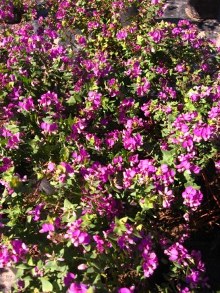 Polygala fruitcosa. Picture courtesy www.newplant.co.zaUses:
Polygala fruitcosa. Picture courtesy www.newplant.co.zaUses:
An interesting use for Polygala myrtifolia, recorded by Pappe, a German doctor and botanist who emigrated to the Cape in 1832 states that the Cape Malays scraped off the fresh grey bark, which they mixed with water and stirred until it frothed, and then used this for washing their dead before burial. This custom, which is now long in disuse, is the reason why, in the Cape this plant is known as “langelier” or” langelede” and probably a corruption of the Afrikaans “lange lede” meaning long joints.
In KwaZulu-Natal Polygala myrtifolia is still recognised today for its antibacterial, antimicrobial, and antifungal properties; and tests done by the University of Natal in Pietermaritzburg found that aqueous extracts of P. myrtifolia showed activity against Candida albicans (which causes oral candidiasis.)
In the Garden:
Colourful and free flowering - polygalas are low maintenance plants that require very little watering once established, making them ideal to plant in the low water usage area of your garden, and in rock gardens. Because they will grow in sun or semi-shade they are perfect for those difficult garden beds that change from full sun to semi-shade with the seasons. They are wonderful for coastal gardens, and a valuable addition to fynbos or Mediterranean gardens. Plant them in shrub borders and on the fringes of woodland gardens, or plant them closely together for an excellent fast growing windbreak or informal screen or hedge. In tiny gardens the taller growing species can even be trained into a small tree. The smaller growing species grow well in containers and make pretty border plants.
The flowers last well in a vase and will attract many insects to the garden, and especially butterflies, honey and carpenter bees. The insects will attract insect-eating birds, and the seeds are relished by laughing doves and other seed-eating birds.
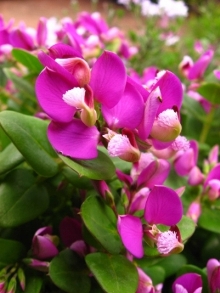 Polygala fruticosa 'Storms River' Picture courtesy www.newplant.co.zaCultivation:
Polygala fruticosa 'Storms River' Picture courtesy www.newplant.co.zaCultivation:
Polygalas are evergreen low maintenance plants which grow quickly, and there are species available for all climates. Some forms are very frost hardy, and all are suitable for windy, coastal gardens. They adapt to most soil types, but prefer well-drained soils that are moderately fertile, so add compost to impoverished soils. Water young plants regularly until they are well established, after which they are quite drought hardy. Mulch the roots to retain moisture during hot, dry spells. Polygalas love full sun, but will also grow well in semi-shade. Trim after flowering to maintain a bushy shape. An occasional feeding with 3:1:5 will be sufficient to maintain good plant health, and will encourage more flowers.
Propagation:
Polygalas grow easily from seed and can seed themselves readily around the garden. They are also easily propagated by cuttings taken in spring or autumn.
Pests & Diseases:
If they are grown correctly, polygalas suffer from no serious pests or diseases.
Warning:
We did not find the species described here listed anywhere as toxic plants, but it is always wise to supervise small children and pets in the garden.
Indian Hawthorn - Raphiolepis
 Raphiolepsis x delacourii 'Pink'Condensed Version:
Raphiolepsis x delacourii 'Pink'Condensed Version:
Indian Hawthorns are popular landscape shrubs for gardens large and small because they remain attractive all year round. Gardeners love their dense, neat growth habit and abundant clusters of delicate pink or white blossoms in late winter and spring, attracting birds and butterflies to the garden. The attractive evergreen leaves are leathery with lightly toothed edges and the new foliage is often an interesting red or bronze, ageing to a rich dark green. Indian hawthorns are fairly slow growing and therefore easily kept at a manageable size; and because they take well to pruning, are ideal for flowering hedges and screening plants. They also work well in mixed shrub borders and flower beds, where they add seasonal interest. Certain varieties make excellent standard plants, requiring clipping only once a year; and all grow beautifully in pots.
Indian hawthorns grow easily throughout South Africa in both the summer and winter rainfall regions. These water-wise plants are drought tolerant once established, but perform best in the garden if watered moderately during long dry spells. Although they thrive in full sun, they can be grown in semi-shade, and in very hot and dry regions, will appreciate a little shade during the hottest time of the day, together with regular watering. Indian hawthorns are hardy to frost and also grow well at the coast where they are resistant to salty winds. They will adapt to most well-drained garden soils, and if they are planted in fertile soil, the plants will need little extra feeding besides a good mulch of compost in autumn and a feeding with a complete organic fertiliser in spring. Pruning can be done at any time but is generally done in early summer, when the plant has finished flowering, but this will prevent the plant from producing its fruits.
Full Version:
Description, History & Interesting Facts:
Raphiolepis is a genus of about fifteen species of evergreen shrubs and small trees in the rose family (Rosaceae), native to warm temperate and subtropical eastern and south-eastern Asia; Japan, Korea, China, Thailand and Vietnam. The common name is a little confusing since it is neither from India, nor does it have thorns like most of the other hawthorns which come from Europe and America. These ornamentals are grown for their dense, neat growth and abundant clusters of delicate pink or white blossoms in late winter and spring; followed by showy blue-black berries in autumn. The leathery oval leaves are glossy with lightly toothed edges; and the new foliage is often red or bronze, ageing to a rich, dark green.
Raphiolepis indica is native to Japan and southern China and grows about 1 to 2m tall. Its oblong leaves are serrated, with new growth emerging with bronze tints and maturing to deep green. Fragrant, white to light pink panicles of flowers appear in spring. It grows well in large containers and is also a popular bonsai specimen.
Raphiolepis umbellata is native to Japan and Korea and has fragrant white flowers. It grows about 2 to 3m tall and about 2.5m wide.
Raphiolepis x delacourii is of garden origin and is the most common variety available in nurseries. It has fragrant white flowers that are flushed with pink and will grow about 1.5 to 2m tall. There are a number of different cultivars of this plant.
Rhaphiolepis x delacourii 'Kruschenia' which has lovely clear-pink flowers and grows about 1.5m tall.
Raphiolepis delacourii 'Anja's Choice' is a new introduction which grows 1 to 5m tall and produces reddish new foliage and dark pink, bi-colour flowers from early winter until early summer. It also grows well in containers.
Other cultivars include a white flowered plant called 'Alba', also known as 'Elsa'; a deep pink form currently under the name of 'Little Susy'; and ‘Spring Rapture' with its pale pink flowers and striking ruby red new foliage.
In the Garden:
Indian Hawthorn is a popular landscape shrub in gardens large and small because they are neat, remain attractive all year round, and because they are fairly slow growing, are easily kept at a manageable size. Because they take well to pruning, Indian Hawthorns are ideal for flowering hedges and screening plants; and also work well in mixed shrub borders or flower beds, where they add seasonal interest. Certain varieties make excellent standard plants and because they are slow growing, are easy to maintain, requiring clipping only once a year. The Indian hawthorn grows beautifully in pots and will attract birds and butterflies to the garden.
Cultivation:
Indian hawthorns grow easily throughout South Africa in both the summer and winter rainfall regions. These water-wise plants are drought tolerant once established, but perform best in the garden if watered moderately during long dry spells. Although they thrive in full sun, they can be grown in semi-shade, and in very hot and dry regions, will appreciate a little shade during the hottest time of the day, together with regular watering. Indian hawthorns are hardy to frost and the leaves will turn a pretty russet colour in winter. They also grow well at the coast where they are resistant to salty winds. The plant will grow near the shore but will benefit from a little protection such as behind the first row of plantings or behind the first dunes. Indian hawthorns will adapt to most garden soils, and if they are planted in well-drained, fertile soil, the plants will need little extra feeding besides a good mulch of compost in autumn and a feeding with a complete organic fertiliser in spring. Pruning can be done at any time but is generally done in early summer, when the plant has finished flowering, but this will prevent the plant from producing its fruits.
Propagation:
Plants can be propagated from semi-hardwood cuttings taken in summer.
Pests & Diseases:
Indian hawthorns are seldom attacked by pests or diseases, but leaf spot can be troublesome, especially in humid regions. To control this, plant in full sun and ensure there is good air circulation around the plant. Also, watch out for aphids, nematodes and scale.
Caution:
Raphiolepis indica is not documented as a toxic plant for humans or animals and the University of California lists it as safe.
Potato Bush - Lycianthes rantonnetii syn. Solanum rantonnetii
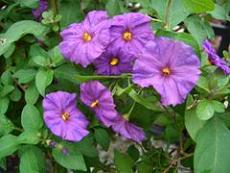 Lycianthes rantonnetii Condensed Version:
Lycianthes rantonnetii Condensed Version:
Lycianthes rantonnetii is a beautiful sprawling woody shrub which grows +-1.5 to 2.5m high with a 1.5 to 2m spread. In warm climates it is evergreen and can bloom almost all year round, but is most prolific during the warmer months. There are several garden cultivars with delicate flowers in shades of blue, violet, purple or white, with bright yellow centres. These versatile ornamentals are suited to most garden styles and situations and are cultivated in frost-free regions all over the world. Because these plants can be pruned into any shape, combined with their dense growth habit, makes them suitable as a hedge or informal screening plant. You can also grow them as a tree or standard plant by removing the lower branches. If only lightly pruned, their tumbling, drooping growth habit makes them ideal for creating an attractive and permanent backdrop for smaller shrubs and perennials.
These sprawling evergreens grow best in warm, moist, frost-free, summer rainfall regions of the country and will tolerate extreme heat and humidity. They are tender to frost but will tolerate light frost if planted in a protected position in the garden. In colder gardens they may lose leaves in winter. Although potato bushes love full sun, they can be planted in light shade; and in the winter rainfall and dry arid regions they will appreciate some shade during the day and regular watering. They grow well at the coast but must be protected from strong winds. These plants respond well to pruning and because they grow extremely fast, will require regular clipping and pinching in order to keep them bushy and compact. A light prune after main flower flushes will also encourage further flower production.They love full sun but will tolerate semi-shade. Potato bushes will grow in sandy, chalky soil but do best in the garden in well composted soil that drains well. Water regularly in summer, never allowing the soil to dry out totally, but take care not to overwater or this may impede flowering. Potato bushes grow best if fertilised regularly, so mulch the roots with compost twice a year, in spring and again in autumn, together with a slow release fertiliser. Potted plants respond well to feeding with a liquid fertiliser.
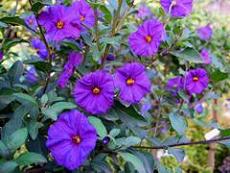 Lycianthes rantonnetii 'Montreaux' Full Version:
Lycianthes rantonnetii 'Montreaux' Full Version:
Description, History & Interesting Facts:
These beautiful free-flowering ornamentals have been confused with the ightshades (Solanum) for a long time. They have now, however, been re-classified as Lycianthes rantonnetii. Lycianthes is apparently closely related to the chili peppers (Capsicum). The potato bush is one of about 150 species in the genus Lycianthes, which are found mostly in tropical regions of the Americas, and others located in the Asia-Pacific region.
Lycianthes rantonnetii is a sprawling woody shrub that comes from Argentina and Paraguay, and grows +-1.5 to 2.5m high with a 1.5 to 2m spread. In warm climates it is evergreen and can bloom almost all year round, but is most prolific during the warmer months. There are several garden cultivars with delicate flowers in shades of blue, violet, purple or white, with bright yellow centres. The flowers will attract butterflies to your garden, and, if left unpruned, the flowers are followed by small red fruits, which will attract birds to the garden.
(Lycianthes rantonnetii) has purple flowers.
(Lycianthes rantonnetii ‘Montreaux’) has deep violet-blue flowers.
(Lycianthes rantonnetii 'White') has snow-white flowers.
(Lycianthes rantonnetii ‘Variegata’) has lovely grey-green and cream leaves and mid-blue flowers.
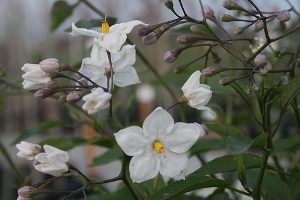 Lycianthes 'White'In the Garden:
Lycianthes 'White'In the Garden:
These versatile ornamentals are suited to most garden styles and situations and are cultivated in frost-free regions all over the world. The Royal Horticultural Society has given Lycianthes rantonnetii their prestigious Award of Garden Merit in 2012.
Because these plants can be pruned into any shape, combined with their dense growth habit, makes them suitable as a hedge or informal screening plant. You can also grow them as a tree or standard plant by removing the lower branches. Standard plants are great to use in small gardens and flowerbeds, and in large garden pots. When they are grown in this fashion, the growth points need to be pinched off very regularly to maintain the formal shape. This also ensures that they remain dense and lush with plenty of flowers.
If only lightly pruned, their tumbling, drooping growth habit makes them ideal for creating an attractive and permanent backdrop for smaller shrubs and perennials. Use them between other large shrubs in the background of a large bed, or in a row against a wire fence or palisade boundary, where their flowers and foliage will peep through, helping to soften their harsh lines.
Because all parts of these plants are poisonous, avoid growing them in areas where very young children play, as they may be tempted to put the bright red berries in their mouths.
 Lycianthes rantonetti 'Variegata' Picture courtesy www.kazimingi.co.zaCultivation:
Lycianthes rantonetti 'Variegata' Picture courtesy www.kazimingi.co.zaCultivation:
These sprawling evergreens grow best in warm, moist, frost-free, summer rainfall regions of the country and will tolerate extreme heat and humidity. They are tender to frost but will tolerate light frost if planted in a protected position in the garden. In colder gardens they may lose leaves in winter. Although potato bushes love full sun, they can be planted in light shade; and in the winter rainfall and dry arid regions they will appreciate some shade during the day and regular watering. They grow well at the coast but must be protected from strong winds. These plants respond well to pruning and because they grow extremely fast, will require regular clipping and pinching in order to keep them bushy and compact. A light prune after main flower flushes will also encourage further flower production.
They love full sun but will tolerate semi-shade. Potato bushes will grow in sandy, chalky soil but do best in the garden in well composted soil that drains well. Water regularly in summer, never allowing the soil to dry out totally, but take care not to overwater or this may impede flowering. Potato bushes grow best if fertilised regularly, so mulch the roots with compost twice a year, in spring and again in autumn, together with a slow release fertiliser. Potted plants respond well to feeding with a liquid fertiliser.
Propagation:
Propagate from tip or semi-hardwood cuttings in summer.
Pests & Diseases:
Watch out for attacks from caterpillars, aphids and thrips. Other issues may include powdery mildew, grey mould, damping off, virus diseases, stem rot and blight.
Warning:
All parts of the Blue Potato Bush are poisonous and may cause severe stomach upset if eaten.
Spiraea, Cape May, Garland Spiraea, Bridal May, Mayflower, Japanese meadowsweet - Spiraea
Spiraea is a genus of deciduous shrubs belonging to the rose family (Rosaceae). The approximately 80 species are native to the temperate Northern Hemisphere, with the greatest diversity in eastern Asia. Most Spiraea species have fine arching stems and simple alternate leaves that are often toothed or lobed. There are both spring and summer flowering species, and most are very ornamental when in full bloom, bearing masses of tiny white to deep pink flowers. The flowers can occur right along the stems or may be clustered in spikes at the tips.
These attractive plants remain popular with gardeners in temperate regions because they are versatile and easy-to-grow, and over the years a number of new garden cultivars with beautiful bronze, gold or yellow coloured foliage have been introduced. The majority of those with coloured leaves are derived from S. japonica which is naturally variable in form, so there are many varieties of it in the horticulture trade. S japonica is native to Japan, China, and Korea, with Southwest China being the centre of biodiversity of the species. It was introduced into cultivation from China by Robert Fortune in about 1850; and was introduced in North America as an ornamental landscape plant and first cultivated in the north-eastern states around 1870. It is now naturalized throughout much of the Northeast, Southeast, and Midwest areas of the United States, and parts of Canada. A common habitat for S. japonica in general seems to be in riparian areas. The word "riparian" is derived from the Latin ripa, meaning river bank; plant habitats along river margins and banks are called riparian vegetation and characterized by plants which have the ability to thrive in seasonally waterlogged conditions. Riparian zones are significant in ecology, environmental management, and civil engineering because of their role in soil conservation.
There are spiraeas for most garden purposes; the taller-growing types can be used for informal hedges and screens, or in mixed shrub borders, and many of the low-growing types are suitable as groundcovers, for low hedges, rockeries and borders, and for planting under windowsills. Because their roots are non-invasive, all varieties are useful to plant on slopes and banks and as screening plants for the foundations of buildings,. Spiraea species will attract butterflies and moths to your garden; being used as food plants by the larvae of some Lepidoptera species including Brown-tail, Emperor Moth, Grey Dagger, Hypercompe indecisa and Setaceous Hebrew Character.
Although these plants like growing near water and cope well with seasonal flooding, they cannot tolerate saturated soils for extended periods of time. In the garden they prefer lots of water during the growing season; but it is essential that the soil drains well or the plants wonât thrive. In dry regions they will need year-round watering, and in the winter rainfall regions, regular summer watering.
Spiraea species perform well throughout South Africa's growing regions, except for the humid areas. They are fully hardy to cold and frost and will tolerate most garden soils, ranging from acidic to slightly alkaline; and are adapted to silt, chalk, clay, silty clay, clay loam, loam, loamy sand, sandy clay loam and sandy loam soils.
Feed with a good general purpose organic fertiliser before new growth begins in spring. In cool climates they perform well if planted in full sun; but in areas with hot summers they will need some shade during the hottest part of the day, or the leaves may scorch.
Because some species flower on the old wood and should be pruned immediately after flowering; and others flower on the current seasons growth and may be trimmed in winter; it can be confusing for the gardener to know when to prune, so the safest time to prune is immediately after flowering. Many gardeners opt to cut out the flowers of the coloured varieties to encourage new leaf growth. If some of the branches of the coloured varieties revert back to green, these shoots must be pruned out immediately, or the more vigorous green shoots will overpower the coloured branches.
Propagation is from softwood or semi-ripe cuttings.
Spiraea suffer from no serious insect or disease problems, but are susceptible to many of the diseases and insects that attack other rose family members, including leaf spot, fire blight, powdery mildew, root rot, aphids, leaf roller and scale.
(Spiraea japonica) Japanese Spiraea. This species forms a small erect, freely branching shrub with a lax habit, growing fairly quickly to +-1.2 to almost 2m in height and about the same in width. Terminal panicles rosy-pink flowers are produced at the ends of the current seasonâs growth. They appear in early summer and continue sporadically until early autumn.
(Spiraea japonica 'Anthony Waterer') This cultivar can bloom in early, mid or late summer, producing flat heads of crimson-pink flowers. It is a rounded, compact shrub which can ultimately reach 1 to 1.5m in height and spread, but because it is slow growing, taking up to 6 to 10 years to reach its ultimate height, it is generally sold as +-90cm tall with an equal spread. Its beautiful green foliage is bronze-red when young, and often irregularly variegated with cream and pink. It makes a fine low-growing informal hedge, and The Royal Horticultural Society has given this plant its prestigious award of Garden Merit.
(Spiraea japonica 'Little Princess') This dwarf spiraea grows +-50cm tall with an equal spread. Its narrow leaves emerge a lovely yellow-green, mature to a rich emerald-green; and turn a lovely coppery-bronze in autumn. It produces prolific clusters of blushing pink flowers in late spring to early summer and makes a lovely ground cover. It is a slow growing plant with a lifespan of up to 20 years, but can take 6 to 10 years to reach its ultimate height.
(Spiraea japonica 'Goldflame') Japanese Meadowsweet. This dwarf spiraea is grown for its beautiful foliage and dark pink flowers in mid to late summer. New leaf growth is bronze-red, turning bright yellow, then eventually mid-green. For the brightest coloured foliage, prune back hard before growth begins in spring. It has an ultimate height of +-60 to 75cm, with an equal spread; but can take 6-10 years to reach its ultimate height. Its compact growth habit makes it ideal for use as a low, informal hedge. The Royal Horticultural Society has given it its prestigious award of Garden Merit.
(Spiraea cantonensis 'Flora Plena') Mayflower. This fast growing shrub has been cultivated by gardeners around the world for generations and is one of the most beautiful ornamental shrubs. If it is not pruned and allowed to assume its natural growth habit it will grow 2 to 3m tall and can spread 1.8m across or more; forming a beautiful domed shape with gracefully arching stems. In mid-spring to summer the branches are completely covered with such a profusion of small double, pure-white flowers that the branches weep under the weight of the blooms. It grows +-1.5 to 2m tall with almost an equal spread, and is an excellent hedging plant.
(Spiraea x vanhouttei) Mayflower. This spiraea has been used in gardens for over a century and is loved for its bushy rounded shape and green leaves which turn orange-red to purple in autumn; and its pure white flowers in late Spring to early summer. It has an ultimate height of +-2.5m and can spread up to 3m; but can take 6 to 10 years to reach its ultimate height. The Royal Horticultural Society has given it its prestigious Award of Garden Merit (AGM).
(Spiraea x van houttei 'Pink Ice') Mayflower. A small growing spiraea with gorgeous green leaves, heavily speckled with white (and sometimes) pink, and new growth which is tinged pink; giving the plant an outstanding appearance if mixed with green foliage shrubs in the garden. It will start flowering during early summer, bearing clusters of small pure white or pink flowers. It is a long-lived, slow-growing shrub which can take 6 to 10 years to reach its ultimate height and spread of +-0.5cm to 1m.
(Spiraea x arguta) Garland Spiraea, Bridal May. This bright green, bushy shrub is a magnificent sight in mid to late spring when its arching branches are draped in single, snow-white flowers. The small leaves turn coppery bronze in fall. This long-lived rounded shrub has an ultimate height of +-1.5 to 2.5m with an equal spread, but it is slow growing and can take 16 to 20 years to reach its ultimate height.
Japanese Spindle Plant - Euonymus japonicus hybrids
 Euonymus japonicusCondensed Version:
Euonymus japonicusCondensed Version:
Japanese Spindle Plants are popular topiary plants which can be clipped into any shape. Because of their bold variegated foliage and dense, upright growth habit, they are an excellent choice for colourful hedges or screens. These medium-sized evergreens vary in height and spread, from +-1 to 2m tall. Hybrids are available in various variegations of dark green and gold or white and cream.
These shrubs grow well throughout the country, except for those exceptionally hot, dry, and humid regions. They do well in coastal gardens, tolerating wind and salt spray, and once established will tolerate drought. They are also hardy to frost, tolerating temperatures down to about -10°C. Euonymus is tolerant of a wide range of soil types, thriving in well-drained loamy soil, and although they grow best in full sun, the plants will take some shade, especially dry shade.
Full Version:
Description, History & Interesting Facts:
Euonymus is native to Japan, Korea and China and is planted for its compact bushy growth and lovely glossy leaves. Hybrids are available with dark green and gold; white or cream variegations. This medium-sized evergreen has hybrids which vary in height and spread, from 1m to 2m tall. They produce small, inconspicuous greenish-white flowers in summer and occasionally, in autumn, little orange fruits appear, hanging below the flaring pink seed coverings.
(Euonymus japonicus 'Aureus') has long leaves, rounded at their ends. The centre of the leaf is golden-yellow, within a broad, irregularly green outer margin.
(Euonymus 'Aureo marginatus') has oval-shaped green leaves, generously edged with gold.
(Euonymus japonicus 'Albo marginatus') has green leaves with white edges.
(Euonymus 'Aureo-variegatus') has gold and green speckled leaves.
(Euonymus japonicus 'Ovatus Aureus') has broad oval leaves with dark green centres, fading to light green; and bright yellow margins.
In the Garden:
Japanese Spindle Plants are popular topiary plants which can be clipped into any shape. Because of their bold variegated foliage and dense, upright growth habit, they are an excellent choice for colourful hedges; and if you are looking for privacy or screening to block off unsightly areas like the compost heap or refuse collection area, then consider these shrubs.
![]() Cultivation/Propagation:
Cultivation/Propagation:
The Japanese spindle plant grows well throughout the country, except for those exceptionally hot, dry and humid regions. It does well in coastal gardens, tolerating wind and salt spray, and once established will tolerate drought. It is also hardy to frost, tolerating temperatures down to about -10°C.
They grow best in full sun but will take some shade, especially dry shade. Euonymus is tolerant of a wide range of soil types, thriving in well-drained loamy soil; but will also grow well in chalk and sandy soils, and well-prepared clay. It prefers alkaline soil conditions, with a pH between 7 and 9 and will benefit from a dressing of agricultural lime in slightly acid soils.
It resents overwatering, but responds well to judicious watering during prolonged dry spells.
Propagate by semi-hardwood cuttings taken in summer.
![]() Problems, Pests & Diseases:
Problems, Pests & Diseases:
High daytime and low night time temperature fluctuations in spring, as well as excessive rainfall and humidity, or too much shade, can favour the development of fungal diseases like powdery mildew. They are also susceptible to scale insects.
Warning:
All parts may cause severe discomfort if ingested.
Escallonia - Escallonia
 Escallonia iveyi 'White'Condensed Version:
Escallonia iveyi 'White'Condensed Version:
Escallonia are super evergreens which look good all year round; with their pleasantly aromatic, glossy dark green leaves, and pretty clusters of small bell-shaped flowers. They flower for a very long time from spring to autumn with blossoms ranging from deep crimson through various shades of pink to white. They make wonderful specimen shrubs in the mixed border and all make excellent formal or informal screening or hedging plants. Escallonias vary in height from +-1.5 to 3m tall and thrive at the coast but do not like high humidity. They also tolerate severe frost, and cold, and adapt to most well drained garden soils. They love full sun but will take light shade.
Full Version:
Description, History & Interesting Facts:
Of the approximately 40 Escallonia shrubs and trees native to South America, 30 grow in Chile. They are super evergreens which look good all year round; with their pleasantly aromatic, glossy dark green leaves, and pretty clusters of small bell-shaped flowers. They flower for a very long time, from spring to autumn; the blossoms ranging from deep crimson through various shades of pink to white, and showing up beautifully against the shiny leaves. The blossoms have a pleasant scent but it is the foliage's lovely spicy aroma when it is damp - reminiscent of Friars Balsam or Allspice - which will have your visitors sniffing your plant with delight.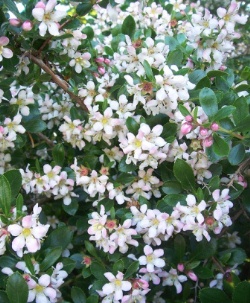 Picture courtesy Leonora Enking Visit her flickr photostreamIn the Garden:
Picture courtesy Leonora Enking Visit her flickr photostreamIn the Garden:
All Escallonia make excellent screening or hedging plants because they have a compact growth habit, grow quickly, and respond well to clipping. Vigorous breeds like 'rubra', 'iveyi' or 'Donard Seedling' can all grow quickly to more than 3 metres which makes them excellent for large hedges or windbreaks. They can be trimmed into any shape and are also used to create formal-looking espaliers. They make excellent windbreaks in coastal regions, because they are very tolerant of salty winds. Escallonia become lovely specimen shrubs in a mixed border and grow beautifully in containers. 'Iveyi' has pure white flowers and 'rubra' has bright rose-red flowers. 'Apple Blossom' is probably the most well known Escallonia, with its lovely pink and white flowers. It grows +-1.5 to 2m tall and is ideal for smaller hedges. 'Pink Princess' and 'Brians Gold' with its yellow leaves and pink flowers are also suitable for smaller hedges.
Cultivation:
Escallonia is fast growing and quickly forms compact bushes. The hybrids vary slightly in height and spread, from +-1.5 to 3m tall. Although they thrive at the coast and tolerate wind, they do not like very humid climates. Once established they tolerate drought, but respond best if watered moderately during dry spells. These remarkable plants also tolerate severe frost, and cold, making them ideal for inland gardens as well. In extremely cold gardens do not plant them in a frost pocket (a typical frost pocket is in a dip or hollow by a fence or wall at the bottom of a sloping garden that traps cold air as it sinks ,and receives sun late in the day during winter). With good drainage Escallonia can withstand -10°C. They thrive in full sun but will take some light shade; in extremely hot gardens, they will appreciate some shade at midday. Escallonia will adapt to almost all garden soil types as long as they drain well, they will even grow in clay soils if the water is able to drain away. The best time to trim them is immediately after flowering. If you want a really formal hedge, you can tidy it up more often, but this may reduce flowering. "Appleblossom" Picture courtesy Leonora Enking Visit her flickr photostreamPropagation:
"Appleblossom" Picture courtesy Leonora Enking Visit her flickr photostreamPropagation:
Escallonia is easily propagated by semi-hardwood cuttings taken in late summer and autumn. Take cuttings +-6cm long, dip them in rooting powder, and plant deeply in a good well-drained soil. Leave only a little foliage on the cutting and water very sparingly; a light misting twice a day should suffice. After a few weeks check the cuttings for roots by gently tugging on a cutting; if roots have formed some resistance will be felt, and it would then be time to transplant them into individual pots.
Pests & Diseases:
Escallonia is normally very pest and disease resistant but can be attacked by wax scale. These soft-bodied insects attach themselves to the leaves or bark and consume the plant's fluids. Large populations of may slow the plant's growth or cause wilting and leaf yellowing. One sign of a scale infestation is a clear, sticky substance covering the plants. The scales release this "honeydew" as a waste product. Thoroughly spraying with horticultural oil like Oleum in late spring or summer suffocates the pests.
Escallonia dieback results in wilting, yellowing or browning of the leaves on certain cultivars, and severe infestations of this disease will kill branches, and sometimes entire plants. Ensuring that they are grown correctly, in well-drained soil and in sufficient sun will help prevent this disease. No effective treatment currently exists.




